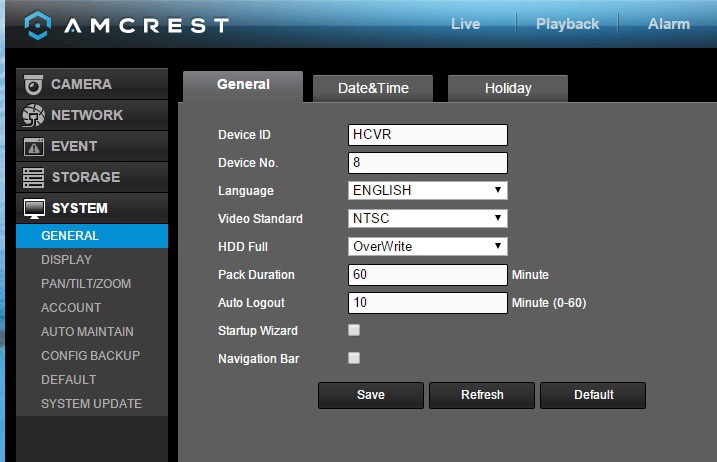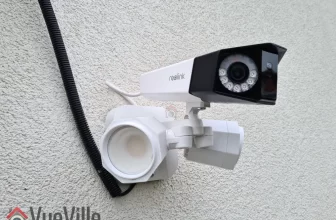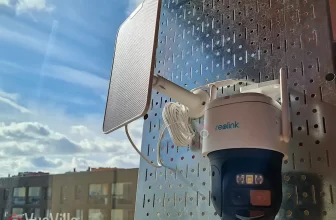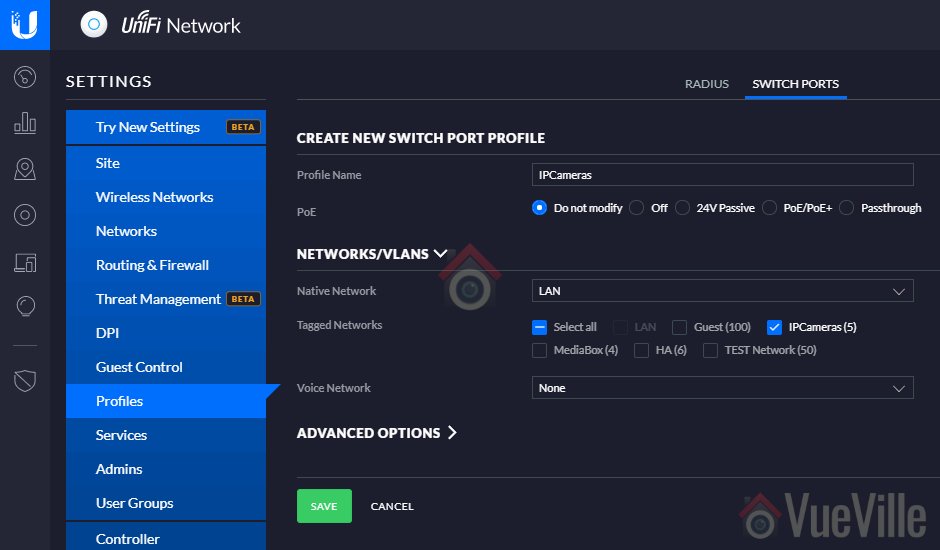Are you looking for a reliable wireless security camera that can act as a baby monitor, a nanny camera, or just to talk to your dog while you are away? The Amcrest ProHD IP2M-841 Wireless Indoor IP Security Camera is what you need: a feature-rich network camera which has great video quality, excellent night vision and crystal clear two-way audio capability. I have been using it for over a year now and here is a hands-on review based on my experience of using it day in and day out.
A quick note: As an Amazon Associate I earn from qualifying purchases. This post contains affiliate link(s). An affiliate link means I may earn advertising or referral fees if you make a purchase through my link, at no extra cost to you.
Making sense of the Amcrest naming convention
If like me, you have been struggling to figure out which Amcrest camera you really need or what the letters and digits in the model number mean, simply refer to our easy-to-use guide to Amcrest cameras. It has a comprehensive list of all the Amcrest security cameras, neatly categorized by indoor/outdoor use and features such as WiFi, PoE.
Briefly this camera has two models based on the colour. Check out the IP2M-841B on Amazon for the black colour model and IP2M-841W on Amazon for the white colour model.
What is the Amcrest ProHD IP2M-841 suitable for?

The Amcrest ProHD IP2M-841 is a versatile surveillance device and its applications are only limited by your imagination! The most common residential indoor security camera applications are:
- As a baby monitor in a nursery (it supports 2-way audio), this is what I use it for
- As a nanny monitor for peace of mind (it is discreet and small enough to be hidden),
- General home security – monitor and secure rooms, hallways, corridors, access and exit points, guesthouses, garages and outhouses (the pan-tilt function gives you installation flexibility).
The common business uses for this sort of IP camera are:
- Monitor and secure office areas, stores, warehouses etc.,
- Observe employees and customers,
- As a visible deterrent against criminal activities.
What’s in the box – Unboxing


Main specifications
| Image Sensor | 1/2.7 ” 2 Megapixel progressive scan CMOS |
| Minimum illumination | 0.1Lux (Colour), 0Lux (IR On) |
| IR LED Range | 10m |
| Focal length | 4mm |
| Angle of view | 90 degrees |
| Bit rate | H.264, 16 - 8192Kbps |
| Ethernet | 10/100 RJ-45 |
| Wi-Fi | 802.11 b/g |
| Protocols | ONVIF, CGI, uPNP, H.264 |
| Storage | SD Card, up to 32GB. |
| Other Connections | Alarm in/out, 3.5mm Audio in/out |
| Power consumption | <7.5W |
| Main stream Frame rate | 1080p/720p @ 30fps |
| Sub stream Frame Rate | VGA/QVGA @ 30fps |
| Audio support | 2-way audio using built-in Mic and Speaker, or 3.5mm Audio in/out connections |
Camera Design



Installation
Amcrest claims that this camera is a doddle to set up and we agree. The camera has a standard camera tripod screw hole (1/4-20 UNC thread) for mounting. The mounting bracket should be able to take at least 3 times the weight of the camera.
Also note that this camera has alarm in and out connections. This means you can use a PIR sensor with this camera instead of relying on software based image detection. Using a PIR will drastically reduce the number of false alerts you may get with just image based motion detection.
Using the Alarm Out connection, you can then make the camera trigger another device to take action such as start recording, send email or push alerts, or execute home automation tasks such as turn on outdoor and indoor lights.
Software Setup
For initial setup, you have to hook up the camera to a power source and connect it to your router via an ethernet cable. The username and password are both ‘admin’. The camera will prompt you to change these, which is an excellent security measure and we commend Amcrest for taking this step. Too many IP cameras connected to the internet still have the default login details and this is an open invitation for hackers, especially if simple port forwarding is in place.
The web administration portal is elegant and thoughtfully laid out with all the options you expect in the right places. However the interface uses an NPAPI plugin like almost all inexpensive security cameras which work only with Internet Explorer and Firefox. It does not work on the Chrome browser but this is not strictly the camera’s fault. Google has decided not to support this plugin in Chrome. Just as other security camera manufacturers will soon have to, we expect Amcrest will redesign the web interface from the ground up in HTML5 to overcome such browser limitations.

The Web Administration page is thoughtfully designed and easy to use
The rest of the setup process is where some users seem to get tripped up. So we have provided our own little overview of how to set up the Amcrest ProHD 1080p camera. Depending on how you want to use the camera, there are different routes to completing the setup process:
Local viewing only (unless you port forward):
- Ethernet cable using IP Config tool, then WiFi, then apps:
- Ethernet cable, IP config tool, change camera’s IP address to your sub-net so that you can access the web setup page.
- Login to web admin page and add WiFi details.
- Install apps on phone, add camera in phone apps:
- Without ethernet cable or IP config tool, using only WiFi:
- Install smartphone apps.
- Scan the QR code and add camera to the app.
Local and Remote viewing, without using Port forwarding:
- P2P setup:
- Connect the camera to your router via ethernet or WiFi(Method 2 above has to be performed first if connecting through WiFi).
- Add camera either via Serial No. or the QR code.
- Amcrest Cloud setup for recording video clips and snapshots to the cloud
- Connect the camera to your router via ethernet or WiFi(Method 2 above has to be performed first if connecting through WiFi)
- Visit www.Amcrest.com/Cloud to add the camera to your cloud account
- Web Access setup (essentially the same as Method 1 but using Amcrest’s servers instead):
- Connect the camera to your router via ethernet or WiFi(Method 2 above has to be performed first if connecting through WiFi)
- Visit www.AmcrestView.com to add the camera to your cloud account
Once the initial setup is complete, you can switch to using the camera’s built-in WiFi.
Here’s a video that walks you through one way of setting up the camera:
Camera Features
Hardware
The Amcrest ProHD IP2M-841 has a 2 Megapixel sensor which lets you record at 1920×1080 resolution and 30 frames per second(fps). This is perfect for home surveillance because you get that much more clarity and sharpness in the recorded videos and images.
The on-board IR has a good range of 10 metres which is standard for this class of IP camera. The lens fitted to the camera has a focal length of 4mm which provides a very good 90 degree field of view. The camera’s pan and tilt functions allow you to point the camera at the area or object of interest.
The camera is capable of recording up to a bitrate of 8Mbps. We recommend a minimum of 4Mbps for ensuring you get a good level of detail. The IP2M-841 supports Wi-Fi upto 802.11g speeds of 54 Mbps. This is more than enough for the camera’s video stream to be sent wirelessly so faster protocols such as 802.11n or ac are not necessary.
What we really like about this camera is that it has an SD card slot, so you have the option of using this camera in a standalone manner. It doesn’t have to be connected to a network device for recording alert videos or images.
Two-way audio is present and is perfect for using the camera as a baby monitor or a wireless doorphone. Watermarking and text overlays are also supported.
Recording modes
The camera can be configured to record 24/7 to the built-in SD card, a network storage location or to the Cloud.
- SD Card: We recommend using the SD card only for motion detection or alert snapshot and video recording, and not 24/7 recording. This is because you will wear out the SD card quicker if you record to it 24/7. Think of the SD card as redundant storage in case your main storage location fails or is stolen.
- The recommended way of using an IP camera is this: use it to record 24/7 footage or motion activated video to a network storage location. This could be a NAS, an NVR (see NVR buying guide), or a computer running surveillance software such as BlueIris.
- Cloud storage: In this mode, your camera will upload motion detection clips, snapshots, or 24/7 recording clips to the Amcrest Cloud.

4 hours of cloud storage are included with the camera, and this should be sufficient for most people intending to use only motion detection recording.
Motion Detection and other event alerts
Motion detection alerts is one of the most enjoyable features of an IP security camera. When an IP camera detects motion as per your pre-defined rules, it should be able to send an email alert with snapshots and ideally send push notifications also. The Amcrest can do all of this and has all the standard motion events that we have come to expect from good quality cameras. It supports email alerts and can attach snapshots with each motion detection email alert. You can also set up each event to be active based on a schedule. An interesting feature of the Amcrest ProHD is that you can also set it up to do a Pan-Tilt tour when it detects motion. Remember you can enable more than one type of event at the same time. Let’s take a closer look at each one of the motion detection events available.
Simple Motion Detection
Amcrest calls it ‘Motion Detect’, this motion detection method simply looks for changes in the scene according to the area defined, the sensitivity and the threshold.
Video Tamper
This method triggers an alert when the camera is blanked out.
Audio Detection
A useful event mode that as the name suggests will trigger an alert and alert actions based on sounds detected by the onboard mic or the audio input.
Alarm
This is where the alarm input connection comes into use. If you have a PIR sensor connected to the camera, you can set up this event to detect motion using the PIR. Since the PIR sensor works on changes in heat and not image based detection, you can cut down the number of false alerts that is the bane of regular image based motion detection.
SD Card abnormality
This event can be set to trigger if the camera is unable to record to the SD card – either because of an error or because somebody has removed the SD card illegally.
Network abnormality
This event can be set to trigger if the camera is unable to record to the network storage location (NAS or NVR) – either because of an error or because somebody has tampered with the equipment.
Illegal Access
This event can be set to trigger if the camera detects unauthorised logins such as an invalid username, password or a hacking attempt.
Smartphone apps
Amcrest provides a free Android and iOS app, the Amcrest View Lite which lets you see your camera’s live video stream, pan and tilt the camera lens, and use the 2-way audio feature. However the free Lite version is missing some important features such as alarm push notifications. The paid Pro version adds alarm push notifications, image and video file sharing, exporting MP4 video, and exporting images to your phone storage. This surprised us because most other manufacturers offer all the Pro version’s features in their free apps. Some users have found the apps to be a bit glitchy though.
Compatibility with NVR systems
The Amcrest ProHD IP2M-841 supports the ONVIF protocol. ONVIF is an industry standard that enables surveillance equipment from different manufacturers to work together. This means that you can connect the Amcrest to any Network Video Recorder(NVR) or a computer running surveillance software, and the camera should work seamlessly.
The camera also supports the RTSP protocol so you can also access the video stream using a video player like VLC on your computer. This is the URL to use: rtsp://login:pass@xxx.xxx.xxx.xxx:PORT/cam/realmonitor?channel=1&subtype=1
The x’s are your camera’s IP address.
Performance
The camera has very good daytime quality thanks to the 1080p image sensor. Videos in low light and at night are also of high quality thanks to the built-in IR LEDs.
I am using my Amcrest as a baby monitor and I’m constantly amazed by how clearly I can see my baby – I can even see his chest moving as he breathes in and out. If you are a parent of an infant, you know how reassuring that can be!
The microphone is super-sensitive and picks up sounds not only in the same room but also from all over the house. So its also a great camera if you want to check in on your house while on vacation.
The builtin speaker is surprisingly loud and I can clearly speak to baby as I make my way to his nursery.
Verdict
The Amcrest ProHD IP2M-841 is one of the best-selling wireless security cameras at the moment. The considerable array of feature such as 1080p FullHD resolution, pan-tilt feature, SD card slot, two-way audio, alarm connections, support for FTP, and configurable event modes in a high quality package represents real value for money.
Note that the only feature this camera is missing in my opinion is PoE. But Amcrest has thought about this already – there is a PoE model, check out the Amcrest ProHD IP2M-841EB on Amazon. The E at the end of the model number indicates that the camera has the PoE feature, the B is just the colour. However it then loses the WiFi ability. Amcrest doesn’t currently make IP cameras with both WiFi and PoE, which is a shame.
Where can I buy one?
We recommend Amazon as they are an authorized retailer of Amcrest security products.
Check Price on your local Amazon Site
Also Consider
- Canary All-in-One Home Security Device
- Belkin NetCam HD+ Wi-Fi Surveillance Camera (added advantage of working with WeMo)
- D-Link DCS-942L Wireless Day/Night Network Surveillance Camera with mydlink-Enabled








Hi Daniel,
I found your review site in my search for wireless IP cameras. I was looking at going one route, but have switched completely after reading your stuff. Top notch.
I’m now looking at Amcrest 2K vs. Reolink C1 pro (latest models as I write this), but one thing is nagging me. The Reolink model has a vertical angle of view (i.e. when camera is stationary) of only 42 degrees; if it weren’t for that I think I would go Reolink. I cannot find vertical angle information for the Amcrest. My first 2 responses from Amcrest were not illuminating (1st: 110 degrees, 2nd: info not available). The 3rd response suggests the vertical angle is 60 to 70 degrees, but I don’t have much confidence in that answer, either (would be great if true). Can you give me a rough ballpark figure of what you think the vertical angle is from the model you have? Or, if easier, a comparison of vertical angle between those 2 cameras.
Cheers
Thanks, glad you found it useful. I have just looked at the video streams from both the Reolink C1 Pro and the Amcrest ProHD, Reolink’s stated 42 degrees seems spot on. The Amcrest 1080p seems to be slightly better. How far away is your camera going to be from your scene? Unless the camera is going to be less than 3-4 feet away from your target, I don’t think you will have a problem with either camera.
I’ve tried a search to find a PIR sensor that would work with this camera, but couldn’t find one. So is this essentially a useless feature?
Cheers
an update and resolution to my problem:
http://forum.micasaverde.com/index.php?topic=38406.msg302983#msg302983
Daniel
Me again… quick question…. Do you have problems with Vera indicating that the Amcrest cameras go “offline” after 60mins of no activity? (“no activity” meaning no interaction between the camera and Vera such as a Vera scene running and no manual access of the camera via the Vera UI) After I get the Vera alert that the camera is offline, I log in to Vera, click on the camera and it comes alive again and I get an alert telling me the camera is “responding again”.
The cameras actually are fine – still running, on the network, and the QNAP NAS/NVR never sees them drop (I have alerts setup from both the QNAP Surveillance Station and from Vera.)
I’m now searching for a “keep alive” concept so I can keep the cameras connected to Vera…but I’d much rather solve the problem rather than put a band aid on it.
No, I haven’t had this problem. Seeing as it is 60 minutes, it may be a timeout value in Vera’s Amcrest camera setting? Or maybe a more generic timeout setting somewhere?